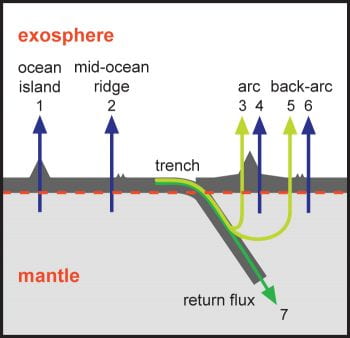We use geochemical tools to investigate links between deep Earth dynamics and the habitability of Earth’s surface over time. To understand why Earth has a nitrogen-rich atmosphere and liquid water ocean – which enabled the evolution of life on Earth – it is critical to understand the planet’s initial state as well as its long-term dynamical evolution. Differences between the Earth and other planetary bodies (Venus, Mars) must also be assessed in light of the coupled evolution of planetary interiors and surfaces.
Mantle outgassing and evolution of Earth’s atmosphere
Ancient atmospheric noble gas signatures have been discovered in geological samples that are billions of years old. Analysis and modeling of ancient terrestrial noble gas signatures provides insight into how the Earth evolved on billion-year timescales. The composition of Earth’s atmosphere tracks volatile origins, volcanic outgassing, and loss of some species to space over time.

Venus atmospheric origins and evolution

The venusian atmosphere is drastically different from Earth’s atmosphere, and He and Ar isotopic ratios measured by prior missions provide tantalizing clues about how Venus may have evolved and diverged from its sister planet, Earth. As part of the science team for a hypervelocity gas sampling probe proposal, I am working on numerical modeling of outgassing and atmospheric loss to provide a map for interpreting the next generation of atmospheric noble gas measurements.
Accretion and the formation of the Moon

A violent accretion process established the Earth’s inventory of volatile compounds. The extent and timescale of volatile loss during terrestrial accretion, particularly in association with the Moon-forming giant impact, are not well-constrained. The Moon-forming giant impact triggered the last catastrophic degassing event on the early Earth. Degassing fractionates lithophile radioactive species from their atmophile radiogenic daughter species. Our research applies a pair of short-lived radionuclide systems (I-Xe and Pu-Xe) to better constrain the timing and nature of volatile loss from the early Earth. Constraints from the radiogenic Rb-Sr system are also used to explore early Solar System volatile loss.
Recent papers: Lock et al. (2020)
Chemical transport at subduction zones

Subduction zones mediate long-term chemical exchange between the Earth’s mantle and surface reservoirs. Detailed assessments of the loss or retention of specific slab components in subduction zone environments are critical to our understanding of the recycling of volatiles such as water and carbon to the deep Earth. A new study in Nature uses Xe isotopic constraints and a numerical modeling approach to better understand the history of volatile transport from the atmosphere into the deep Earth. See our detailed blog post summarizing the study. We also published a study that used H2O mass balance and constraints on sea level change to set limits on the amount of water subducted beyond depths of magma generation. We have ongoing projects looking into the cycling of volatiles through subduction zones based on emerging stable isotope tracers (strontium, boron).
The nature of heterogeneity in Earth’s mantle
The rich variety of chemical signatures measured in mantle-derived rocks tells us about an integrated 4.5 billion year history of deep Earth chemical transport. Noble gas isotopes provide a powerful set of linked radiogenic systems (e.g., U-Th-He, U-Xe, Pu-Xe, I-Xe) that can be leveraged to examine the generation of mantle heterogeneity on a variety of lengthscales and timescales.
The nature of mantle plumes:
- Cook-Austral He and Ne and the nature of the HIMU mantle source (PDF)
- Review paper on mantle plume noble gas signatures (PDF)
Heterogeneity in the upper mantle: